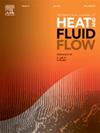Vapor quality distribution in a microchannel heat exchanger Header: Impact of downward and horizontal distributor spraying
IF 2.6
3区 工程技术
Q2 ENGINEERING, MECHANICAL
International Journal of Heat and Fluid Flow
Pub Date : 2025-04-01
DOI:10.1016/j.ijheatfluidflow.2025.109828
引用次数: 0
Abstract
The vapor quality distribution in the header of a microchannel heat exchanger significantly affects the refrigerant charge, distribution, pressure drop, and heat transfer efficiency. However, the distribution differs markedly with and without a distributor. This study examines the use of a 2 mm nozzle in a 5 mm inner diameter circular tube as a distributor in an inlet header, spraying R134a into the header. Capacitance measurements are analyzed to characterize the distribution under two orientations: downward and horizontal, and compare with a no-distributor configuration. The test conditions cover inlet vapor qualities from 0.1 to 0.6 and mass flow rates of 5, 7, and 10 g-s−1. The local vapor qualities are calculated based on the capacitance. For the downward configuration, distribution is relatively uniform at lower vapor qualities as the flow rate increases. The local vapor quality on the left side of the nozzle typically exceeds that on the right. For the horizontal configuration, a bimodal distribution is observed, except at high flow rates and vapor qualities ( = 10 g-s−1 and > 0.4). For both configurations, vapor phase superficial velocity is the key parameter influencing distribution. A comparison shows that the downward configuration improves uniformity at the inlet vapor qualities below 0.4.
求助全文
约1分钟内获得全文
求助全文
来源期刊

International Journal of Heat and Fluid Flow
工程技术-工程:机械
CiteScore
5.00
自引率
7.70%
发文量
131
审稿时长
33 days
期刊介绍:
The International Journal of Heat and Fluid Flow welcomes high-quality original contributions on experimental, computational, and physical aspects of convective heat transfer and fluid dynamics relevant to engineering or the environment, including multiphase and microscale flows.
Papers reporting the application of these disciplines to design and development, with emphasis on new technological fields, are also welcomed. Some of these new fields include microscale electronic and mechanical systems; medical and biological systems; and thermal and flow control in both the internal and external environment.
 求助内容:
求助内容: 应助结果提醒方式:
应助结果提醒方式:


